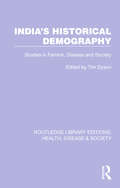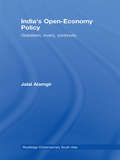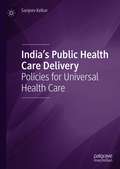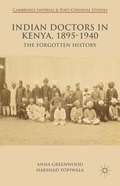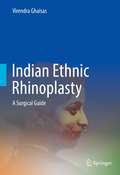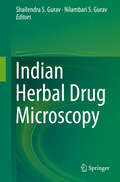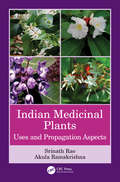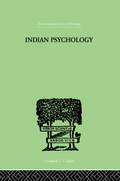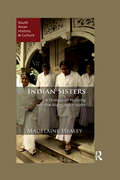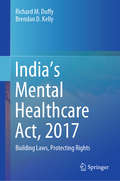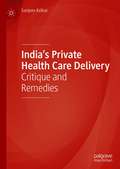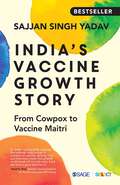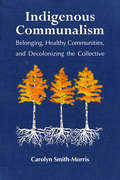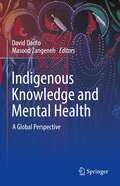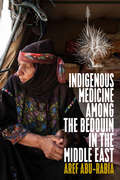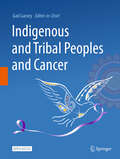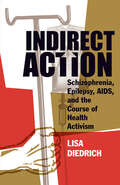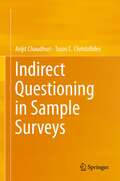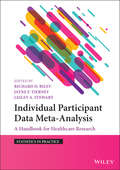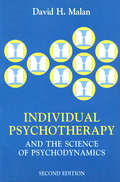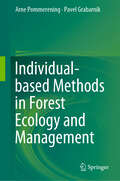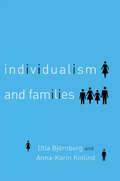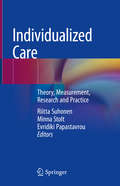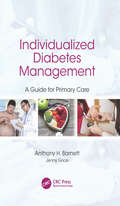- Table View
- List View
India's Historical Demography: Studies in Famine, Disease and Society (Routledge Library Editions: Health, Disease and Society #12)
by Tim DysonWhen this book was originally published in 1989 here had been virtually no studies of the country’s historical demography. This volume was significant for 3 reasons: it contributed greatly to the knowledge of India’s population history; it had major implications for the work of social and economic historians of India; and lastly the Indian context provides an excellent laboratory in which to investigate certain large-scale demographic phenomena – among others the experience of bubonic plague, influenza, cholera and famine.
India's Open-Economy Policy: Globalism, Rivalry, Continuity (Routledge Contemporary South Asia Series #Vol. 14)
by Jalal AlamgirThis book is the first major exploration of Indian political economy using a constructivist approach. Arguing that India’s open-economy policy was made, justified, and continued on the basis of the idea of openness more than its tangible effect, the book explains what sustained the idea of openness, what philosophy, interpretations of history, and international context gave it support, justification, and persuasive force. Drawing on a wide range of contemporary and historical sources, and going as far back as the 19th century, the author reconstructs how Indian policymakers have interpreted economic priorities, perceived success and failure, and evaluated the destiny of their nation. By the 1990s, their imperatives increasingly highlighted a sense of rivalry, especially with China, and globalism, a desire to play a strong role in world affairs. The book shows how a sense of nationalist urgency was created through globalism and rivalry, allowing policymakers to privilege international needs over domestic political demands, replace economic independence with interdependence as a priority, and ensure that the broad basis of India’s openness could not be challenged effectively even though certain policies faced severe opposition. This book will be of interest to those working on International Political Economy, Globalization, Economic History, Public Policy, and South Asian politics.
India's Public Health Care Delivery: Policies for Universal Health Care
by Sanjeev KelkarThis book describes the present awful state of India’s Public Health Care Delivery, its dismal planning and implementation. It argues that it can be remedied comprehensively and effectively, using its ‘own already present’ resources. A radical re-evaluation of some sacrosanct ideas and discarding many of these, especially in Primary Care and its structure is required. It can be done without disadvantage to the last man served. This book starts with the sea change India has undergone and emphasizes new ways of managing health. High quality work force creation and its deployment, an unsolved problem is effectively given a solution. The bulk of the book discusses the entire public health care structure and function and how it can be newly laid out with proper work force allocation, hitherto grossly inadequate, including professionals from other training backgrounds. It is total solution that will help India to achieve the goal of Universal Health Care.
Indian Doctors in Kenya, 1895–1940
by Anna Greenwood Harshad TopiwalaThis ground-breaking book offers unique insights into the careers of Indian doctors in colonial Kenya during the height of British colonialism, between 1895 and 1940. The story of these important Indian professionals presents a rare social history of an important political minority.
Indian Ethnic Rhinoplasty: A Surgical Guide
by Virendra GhaisasEach racial and ethnic population has their own nasal characteristics, which need to be considered when planning rhinoplasty surgery. This book is probably the first of its kind in the Indian context highlighting the goal of maintaining ethnic identity congruent with the patient’s facial features and establishing Indian standards for gauging the success of the surgery. This is important as most of the rhinoplasty books have addressed these issues of the Caucasian or southeast Asian population and Caucasian normative standards of facial analysis. This book provides a broader understanding of ethnically specific features. It highlights the regional variations within India and their implications for rhinoplasty Surgery, thereby filling the void of lack of knowledge of the intricacies of surgery on Indian noses. It deals with important topics such as preoperative evaluations, determining factors such as thickness and texture of skin along with the various complications that may be encountered. It simplifies and facilitates learning with numerous pre-operative, intra-operative, and postoperative photographs. This book provides a systematic approach to Rhinoplasty surgery in Indian patients with an emphasis on addressing the functional aspects along with the cosmetic aspects. This book is a must-have for trainees in rhinoplasty and plastic surgery courses along with facial plastic surgeons, maxillofacial surgeons, and aesthetic surgeons operating on the Indian population across the globe.
Indian Herbal Drug Microscopy
by Shailendra S. Gurav Nilambari S. GuravAdulteration and misidentification of herbal drugs can cause serious health problems to consumers. The first step in quality control of medicinal plants is ensuring the authenticity of the desired species for intended use, with anatomical study playing a critical role in identifying and authenticating medicinal plants. A product of numerous years of experience and research, Indian Herbal Drug Microscopy is a vital resource for identifying and evaluating Indian medicinal plants. Comprised of four concise and comprehensive chapters, the book presents stepwise procedures for sectioning of plant material, histo-chemical staining techniques, and the anatomy of forty well-known and medicinally important plants, including Arjuna, Ashoka, Ashwagandha, Cinchona, Cinnamon, Ginger, Kurchi, Rauwolfia, Turmeric, Tulsi, and Vasaka. The book is also supplemented with color photographs and hand-drawn microscopic images. Written by authorities in the field, Indian Herbal Drug Microscopy is a valuable guide for herbal drug microscopy of Indian medicinal plants.
Indian Herbal Medicines: Antioxidant and Antimicrobial Properties (SpringerBriefs in Molecular Science)
by Maria Micali Ramesh Kumar Sharma Rajeev K. Singla Alessandra Pellerito Bhupendra Kumar RanaThis book discusses the scope and limitations of the antimicrobial and antioxidant properties of foods as medicines or medicinal coadjuvants in traditional Indian herbal therapies. The first chapter introduces readers to the relevance of the Ayurveda system, its holistic classification approach, applications of selected herbs and the demonstrable efficacy of herbal extracts in terms of antimicrobial susceptibility. In turn, the second chapter discusses the antimicrobial properties and kinetic mechanisms of inhibition ascribed to selected vegetable extracts. The third chapter addresses the antioxidant power of phenolic compounds from vegetable products and herbal extracts. The book closes with a review of natural antioxidant agents’ role in the treatment of metabolic disorders. Written from an Indian perspective, this book unravels the chemistry of the traditional Indian diet and its impact on health. Further, it can serve as a reference for other traditional products with similar health claims.
Indian Medicinal Plants: Uses and Propagation Aspects
by Akula Ramakrishna Srinath RaoThe demand for medicinal plants is increasing, and this leads to unscrupulous collection from the wild and adulteration of supplies. Providing high-quality planting material for sustainable use and thereby saving the genetic diversity of plants in the wild is important. In this regard, the methods of propagation of some important medicinal plants are provided along with the traditional methods of propagation. Indian Medicinal Plants: Uses and Propagation Aspects offers a unique compendium of more than 270 medicinal plant species from India with detailed taxonomic classifications based on the Bentham and Hooker system of classification. Salient Features: Provides traditional methods of propagation and discusses the propagation of medicinal plants Presents plant properties, plant parts and chemical constituents Describes the medicinal uses of more than 270 medicinal plant species from India This book is of special interest to practitioners of alternative medicine, students of Ayurveda, researchers and industrialists associated with medical botany, pharmacologists, sociologists and medical herbalists.
Indian Psychology Perception: Cognition; Emotion And Will; Epistemology Of Perception (Psychology Ser.)
by Sinha, JadunathFirst Published in 1999. Routledge is an imprint of Taylor & Francis, an informa company.
Indian Sisters: A History of Nursing and the State, 1907–2007 (South Asian History and Culture)
by Madelaine HealeyHealth and medicine cannot be understood without considering the role of nurses, both as professionals and as working women. In India, unlike other countries, nurses have suffered an exceptional degree of neglect at the hands of state, a situation that has been detrimental to the quality of both rural and urban health care. Charting the history of the development of nursing in India over 100 years, Indian Sisters examines the reasons why nurses have so consistently been sidelined and excluded from health care governance and policymaking. The book challenges the routine suggestion that nursing’s poor status is mainly attributable to socio-cultural factors, such as caste, limitations on female mobility and social taboos. It argues instead that many of its problems are due to an under-achieved relationship between a patriarchal state on the one hand, and weak professional nursing organisations shaped by their colonial roots on the other. It also explores how the recent phenomenon of large-scale emigration of nurses to the West (leading to better pay, working conditions and career prospects) has transformed the profession, lifting its status dramatically. At the same time, it raises questions about the implications of emigration for the fate of health care system in India. An important contribution to the growing academic genre of nursing history, the book is essential reading for scholars and students of health care, the history of medicine, gender and women’s studies, sociology, and migration studies. It will also be useful to policymakers and health professionals.
India’s Mental Healthcare Act, 2017: Building Laws, Protecting Rights
by Brendan D. Kelly Richard M. DuffyThis book comprehensively discusses the background to the passing of India's revolutionary Mental Healthcare Act, 2017, offering a detailed description of the Act itself and a rigorous analysis in the context of the CRPD and the World Health Organization (WHO) standards for mental health law. It examines the fine balance, between complying with the CRPD while still delivering practical, humane, and implementable legislation. It explores how this legislation was shaped by the WHO standards and provides insights into areas where the Indian legislators deviated from these guidelines and why. Taking India as an example, it highlights what is possible in other low- and middle-income countries. Further it covers key issues in mental health, identifying potential competing interests and exploring the difficulties and limitations of international guidelines.The book is a valuable resource for psychiatrists, nurses, social workers, non-governmental organizations and all mental healthcare workers in India and anyone studying human rights law.
India’s Private Health Care Delivery: Critique and Remedies
by Sanjeev KelkarThis book brings together all the major components of the private health care sector in India, with detailed description of its evolution, the foundational ideas, its development, the positives and ill effects on the population. It suggests intelligible and practical remedies for public good. The book presents a comprehensive review of private health care sector’s resistance to Indian Government’s reforms like the national medical commission, NEET, clinical establishment act and the new boost to the traditional medicine by the Indian government. The author has discussed contentious areas like Corporate Hospitals, Capitation Fee Colleges, Pharmaceutical Industry, Western Models in Health Care, Integration of Medical Systems, Ayushman Bharat Scheme, Health Insurance and Public Private Partnership on a massive scale.
India’s Vaccine Growth Story: From Cowpox to Vaccine Maitri
by Sajjan Singh YadavDid you know that vaccines save 3 million lives annually? This potent group of weapons has notably annihilated smallpox, pushed polio to the verge of elimination and is now taking on COVID-19 as the dreaded virus keeps changing forms to survive in its fierce battle with humankind. Indians practised inoculation centuries before the West discovered vaccines in 1796. India’s Vaccine Growth Story charts the journey of vaccines from the Jennerian era to the COVID-19 pandemic, covering multiple facets of vaccines, from the Indian and global perspective. Apart from discussing vaccine leadership, vaccine nationalism, vaccine hesitancy, eagerness and equity, as well as the latest diplomatic currency—the vaccine-maitri, the book also tracks the decade-long vaccine development cycle that was drastically cut short to a few months, taking readers through India’s exciting and meticulously-planned sojourn of executing the world’s largest vaccination drive.
Indigenous Communalism: Belonging, Healthy Communities, and Decolonizing the Collective
by Carolyn Smith-MorrisFrom a grandmother’s inter-generational care to the strategic and slow consensus work of elected tribal leaders, Indigenous community builders perform the daily work of culture and communalism. Indigenous Communalism conveys age-old lessons about culture, communalism, and the universal tension between the individual and the collective. It is also a critical ethnography challenging the moral and cultural assumptions of a hyper-individualist, twenty-first century global society. Told in vibrant detail, the narrative of the book conveys the importance of communalism as a value system present in all human groups and one at the center of Indigenous survival. Carolyn Smith-Morris draws on her work among the Akimel O'odham and the Wiradjuri to show how communal work and culture help these communities form distinctive Indigenous bonds. The results are not only a rich study of Indigenous relational lifeways, but a serious inquiry to the continuing acculturative atmosphere that Indigenous communities struggle to resist. Recognizing both positive and negative sides to the issue, she asks whether there is a global Indigenous communalism. And if so, what lessons does it teach about healthy communities, the universal human need for belonging, and the potential for the collective to do good?
Indigenous Knowledge and Mental Health: A Global Perspective
by Masood Zangeneh David DantoThis book brings together Indigenous and allied experts addressing mental health among Indigenous peoples across the traditional territories commonly known as the Americas (e.g. Canada, US, Caribbean Islands, Mexico, Bolivia, Venezuela, Ecuador and Brazil), Asia (e.g. China, Korea, Japan, Taiwan and Indonesia), Africa (e.g. South Africa, Central and West Africa) and Oceania (New Guinea and Australia) to exchange knowledge, perspectives and methods for mental health research and service delivery. Around the world, Indigenous peoples have experienced marginalization, rapid culture change and absorption into a global economy with little regard for their needs or autonomy. This cultural discontinuity has been linked to high rates of depression, substance abuse, suicide, and violence in many communities, with the most dramatic impact on youth. Nevertheless, Indigenous knowledge, tradition and practice have remained central to wellbeing, resilience and mental health in these populations. Such is the focus of this book.
Indigenous Medicine among the Bedouin in the Middle East
by Aref Abu-RabiaModern medicine has penetrated Bedouin tribes in the course of rapid urbanization and education, but when serious illnesses strike, particularly in the case of incurable diseases, even educated people turn to traditional medicine for a remedy. Over the course of 30 years, the author gathered data on traditional Bedouin medicine among pastoral-nomadic, semi-nomadic, and settled tribes. Based on interviews with healers, clients, and other active participants in treatments, this book will contribute to renewed thinking about a synthesis between traditional and modern medicine - to their reciprocal enrichment.
Indigenous and Tribal Peoples and Cancer
Although cancer survival has improved markedly in developed countries in recent decades, not all groups have benefited equally. In particular, Indigenous and Tribal peoples continue to have poorer cancer outcomes than their non-Indigenous counterparts. The available evidence suggests these disparities are linked to a complex combination of factors, including higher incidence of cancers associated with a high case fatality, later stage of diagnosis, reduced access to cancer treatment, and poorer overall health. Much research is underway to explore approaches to improving health system responses for Indigenous and Tribal peoples. A developing evidence base is supporting effective translation of knowledge into practice. This book offers a global perspective on this evidence base, written from Indigenous perspectives. This book is the first comprehensive publication to report on cancer incidence, mortality, prevalence, survival, and inequities for Indigenous and Tribal peoples globally, with the aim of enhancing global efforts to improve outcomes for these populations. Its content and approach are led by Indigenous researchers with international reputations in health and cancer research. Chapters provide important information and data to support Indigenous-specific, targeted cancer awareness and early detection campaigns. This book goes beyond a discussion of the issues and challenges in Indigenous health, with a strengths-based approach to discussing successful health interventions, research projects, research translation, and living well – both with and beyond cancer. This is an open access book.
Indirect Action: Schizophrenia, Epilepsy, AIDS, and the Course of Health Activism
by Lisa DiedrichThe experience of illness (both mental and physical) figures prominently in the critical thought and activism of the 1960s and 1970s, though it is largely overshadowed by practices of sexuality. Lisa Diedrich explores how and why illness was indeed so significant to the social, political, and institutional transformation beginning in the 1960s through the emergence of AIDS in the United States. A rich intervention—both theoretical and methodological, political and therapeutic—Indirect Action illuminates the intersection of illness, thought, and politics.Not merely a revision of the history of this time period, Indirect Action expands the historiographical boundaries through which illness and health activism in the United States have been viewed. Diedrich explores the multiplicity illness–thought–politics through an array of subjects: queering the origin story of AIDS activism by recalling its feminist history; exploring health activism and the medical experience; analyzing psychiatry and self-help movements; thinking ecologically about counterpractices of generalism in science and medicine; and considering the experience and event of epilepsy and the witnessing of schizophrenia. Indirect Action places illness in the leading role in the production of thought during the emergence of AIDS, ultimately showing the critical interconnectedness of illness and political and critical thought.
Indirect Questioning in Sample Surveys
by Tasos C. Christofides Arijit ChaudhuriIndirect questioning is a crucial topic in surveys of human populations. When the issue is about a stigmatizing characteristic (for example about illegal drug use), standard survey methodologies are destined to fail because, as expected, people are not willing to reveal incriminating information or information violating their privacy. Indirect questioning techniques have been devised so that the privacy of participants in a sample survey is protected and at the same time good estimates of certain parameters (e.g. the percentage of people in a certain community who use illegal drugs) can be delivered. The topic is modern and still under development. Indirect Questioning in Sample Surveys represents a collection of the most important and recent techniques of indirect questioning, including various versions of randomized response, the item count technique, the nominative technique, the three-card method, non-randomized response models and negative surveys, while also exploring the key aspect of protecting privacy.
Individual Participant Data Meta-Analysis: A Handbook for Healthcare Research (Statistics in Practice)
by Richard D. Riley Jayne F. Tierney Lesley A. StewartIndividual Participant Data Meta-Analysis: A Handbook for Healthcare Research provides a comprehensive introduction to the fundamental principles and methods that healthcare researchers need when considering, conducting or using individual participant data (IPD) meta-analysis projects. Written and edited by researchers with substantial experience in the field, the book details key concepts and practical guidance for each stage of an IPD meta-analysis project, alongside illustrated examples and summary learning points. Split into five parts, the book chapters take the reader through the journey from initiating and planning IPD projects to obtaining, checking, and meta-analysing IPD, and appraising and reporting findings. The book initially focuses on the synthesis of IPD from randomised trials to evaluate treatment effects, including the evaluation of participant-level effect modifiers (treatment-covariate interactions). Detailed extension is then made to specialist topics such as diagnostic test accuracy, prognostic factors, risk prediction models, and advanced statistical topics such as multivariate and network meta-analysis, power calculations, and missing data. Intended for a broad audience, the book will enable the reader to: Understand the advantages of the IPD approach and decide when it is needed over a conventional systematic review Recognise the scope, resources and challenges of IPD meta-analysis projects Appreciate the importance of a multi-disciplinary project team and close collaboration with the original study investigators Understand how to obtain, check, manage and harmonise IPD from multiple studies Examine risk of bias (quality) of IPD and minimise potential biases throughout the project Understand fundamental statistical methods for IPD meta-analysis, including two-stage and one-stage approaches (and their differences), and statistical software to implement them Clearly report and disseminate IPD meta-analyses to inform policy, practice and future research Critically appraise existing IPD meta-analysis projects Address specialist topics such as effect modification, multiple correlated outcomes, multiple treatment comparisons, non-linear relationships, test accuracy at multiple thresholds, multiple imputation, and developing and validating clinical prediction models Detailed examples and case studies are provided throughout.
Individual Psychotherapy and the Science of Psychodynamics, 2Ed
by Lynn Parker David MalanDr Malan's iconic book is firmly established as a classic psychotherapy textbook and it remains extremely popular. The second edition of this highly individual and fascinating text brings theory and practice up to date, while keeping the essential character of the book unchanged.The book offers an invaluable description of dynamic psychotherapy and
Individual-based Methods in Forest Ecology and Management
by Arne Pommerening Pavel GrabarnikModel-driven individual-based forest ecology and individual-based methods in forest management are of increasing importance in many parts of the world. For the first time this book integrates three main fields of forest ecology and management, i.e. tree/plant interactions, biometry of plant growth and human behaviour in forests. Individual-based forest ecology and management is an interdisciplinary research field with a focus on how the individual behaviour of plants contributes to the formation of spatial patterns that evolve through time. Key to this research is a strict bottom-up approach where the shaping and characteristics of plant communities are mostly the result of interactions between plants and between plants and humans. This book unites important methods of individual-based forest ecology and management from point process statistics, individual-based modelling, plant growth science and behavioural statistics. For ease of access, better understanding and transparency the methods are accompanied by R code and worked examples.
Individualism and Families: Equality, Autonomy and Togetherness
by Ulla Bjornberg Anna-Karin KollindAlmost all women and men claim that gender equality within their relationships is the ideal. In practice, however, equality is not predominant within many couples and families. This book develops current debates about individualisation within families – particularly how partners understand and resolve tensions between the need for togetherness and personal autonomy, and how partners view and work with increasing gender equality. Individualism and Families is based on a large Swedish study from two of the foremost European experts on the sociology of the family. The study looks particularly at partnering, parenting, intimacy, commitments, attitudes to finances and gender divisions of labour.
Individualized Care: Theory, Measurement, Research And Practice
by Riitta Suhonen Minna Stolt Evridiki PapastavrouThis contributed book is based on more than 20 years of researches on patient individuality, care and services of the continuously changing healthcare system. It describes how research results can be used to respond to challenges on individuality in healthcare systems. Service users’, patients’ or clients’ point of views on care and health services are urgently needed. This book describes the conceptualisation of the individualized nursing care phenomenon and the process development of the measuring instruments of that phenomenon in different contexts. It describes results from a variety of clinical contexts about individualized nursing care and explains factors associated with the perceptions and delivery of individualized nursing care from different point of views. This book may appeal to clinicians, nurses practitioners and researchers from many fields.
Individualized Diabetes Management: A Guide for Primary Care
by Anthony Barnett Jenny GriceIn the past few decades a revolution in our approach to treating type 2 diabetes has occurred following the recognition that the condition is caused by multiple defects. A range of new treatments are now available, with many more forthcoming, utilising differing mechanisms of action that allow targeted and more effective therapy of this multifactorial disease than ever before. <P><P>The increasing requirement in the UK to move much of diabetes practice into the community requires much more detailed knowledge of the condition by GPs and practice nurses. In this bespoke book, the authors aim to show how new mechanisms of glucose control and advances in treatments arising from this can tailor treatment to the individual in primary care. This book incorporates the recently published ADA/EASD guidelines and the 2015 update from the National Institute for Health and Clinical Excellence (NICE). <P><P>Essential reading for the multi-professional diabetes care team, this book should also be of interest to hospital specialists in training.
